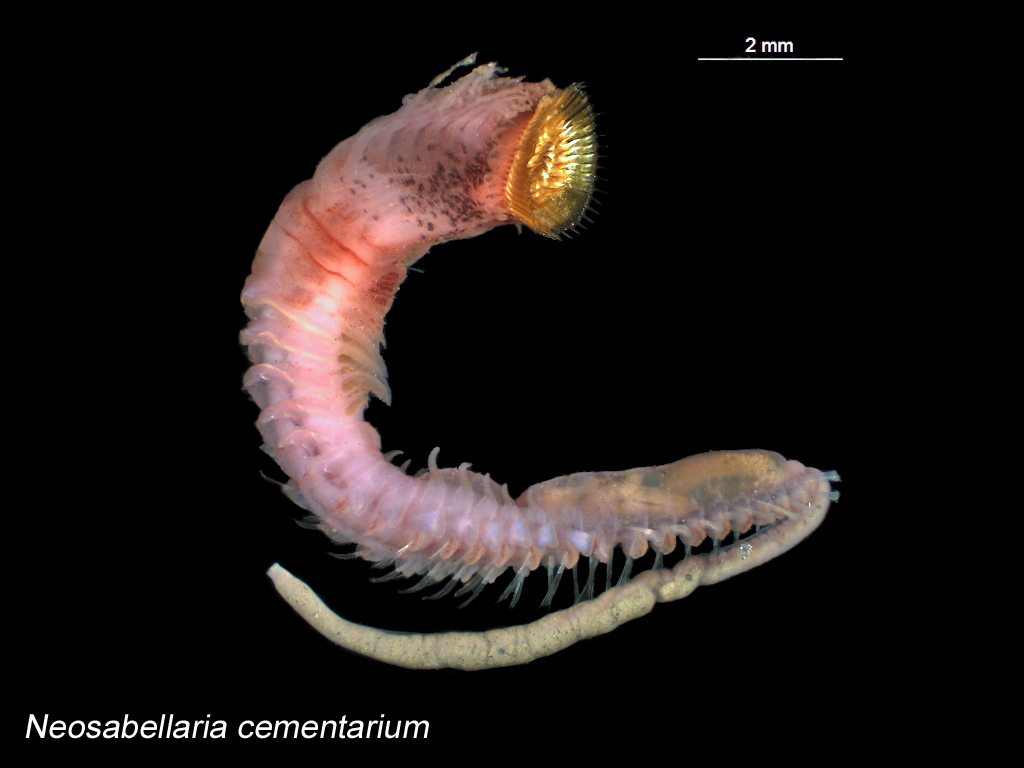Brick and mortar
The false sandcastle worm belongs to the family Sabellariidae, a group of marine annelids known for their tube-building abilities. Lots of worms glue sand or mud together to make dwellings, but the sabellariid tube is in a class of its own. We are talking "benthic brick house" — hard as a rock and very difficult to break apart. The secret is in the “mortar” — a mucous-protein cement that is secreted from a U-shaped gland behind the worm’s head, called (very aptly) the building organ.
Don’t worry - you won’t unearth these worms while constructing your own castles in the sand. The false sandcastle worm prefers to work its architectural magic below the low water line, in intertidal to subtidal depths from Alaska to Southern California.
Tiny tube living
The false sandcastle worm spends its entire life in its 4 mm-wide tube, and it has some amazing adaptations to make tiny tube life a bit easier. Thick golden hairs called paleae on the worm’s head interlock to form an operculum, or door, that plugs the tube at the top. Not only does this keep predators at bay, but at low tide, it can seal a fresh batch of sea water inside. A pair of branchiae, or gills, on each body segment pulls oxygen from the trapped water until the tube is re-submerged.
A whole N. cementarium specimen from Bellingham Bay with tube removed.
True or false?
So… what makes our Puget Sound species “false,” anyway? When this critter was described in 1906, the name “sandcastle worm” was already taken — by its much-more-famous cousin, Phragmatopoma californica from Southern California. You tell these two brilliant builders apart simply by color. Unlike Neosabellaria cementarium’s golden crown, P. californica’s tentacles and operculum are royal purple. A live specimen of Phragmatopoma californica collected from San Pedro, Los Angeles. Photo by Josh Silberg, Hakai Institute.
Honeybunch
These two species can also be distinguished by the grandness of the structures they create. P. californica sticks its tubes together in amazing reefs that, when exposed at low tide, make parts of the California coast look like the surface of the moon. With all the tube openings pointing in the same direction, the formations resemble the honeycomb structure of bees, giving rise to the alternate family name, “honeycomb worms.” Whatever you call them, these worm reefs actually function like real reefs, providing habitat for organisms like sponges, bryozoans, and tunicates. Many species of worms use the empty tubes and crevices for shelter. And of course, predators like fish and hermit crabs love feasting on the sandcastle worms’ tentacles when they are extended during feeding.
I’ll settle for you
You might be wondering how a tiny worm larva floating around in the water column finds its future castle-mates. All baby sabellariids need sand to induce metamorphosis into their adult form, and to tell them where it is suitable to settle. Reef-building species like P. californica respond best to sand that’s already been made into tubes by adults of their own species. Fatty acids in the mucous cement of the tubes give off a unique chemical signature that the larvae follow like a road map to their sandy settling ground.
Going it alone
The false sandcastle worm, on the other hand, is more of a loner. Throughout most of its range, it prefers to shack up by itself rather than adding on to a giant worm fortress. In laboratory experiments, the larvae showed no preference between the tubes of their brethren and plain old sand, suggesting that this species does not aggregate in response to a chemical cue. They generally colonize rocks or even the shells of bivalves (like the spiny pink scallop) in small numbers, instead of forming reefs. This small Puget Sound pebble from Bellingham Bay has several Neosabellaria cementarium tubes attached to it.
Worms of a feather
There are exceptions to this rule, however. Scientists diving near Coos Bay, Oregon in the late 1990s discovered an extensive worm reef composed largely of N. cementarium tubes — something that had not been observed in the area before. There is a similar aggregation in Northern Puget Sound. Perhaps reef-building occurs where sandy substrate is limited, or when conditions are just too perfect to pass up.
Amazingly, there’s one thing the worms are never desperate enough to do. In parts of California where the ranges of the “true” and “false” sandcastle worms overlap, they don’t intermingle… ever. I guess a worm’s home really is its castle and no other’s!
Critter of the Month
Dany is a benthic taxonomist, a scientist who identifies and counts the sediment-dwelling organisms in our samples as part of our Marine Sediment Monitoring Program.We track the numbers and types of species we see to detect changes over time and understand the health of Puget Sound.







